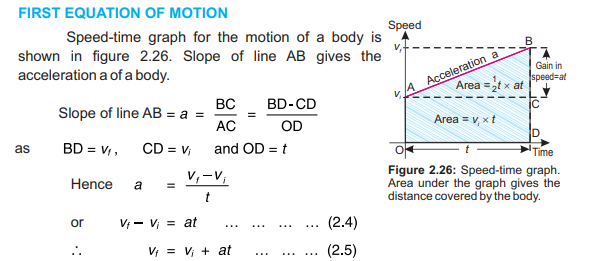First Equation of Motion – Physics 9th Class Chapter 1 Lecture 3
Understanding the First Equation of Motion: Unveiling the Foundations of Kinematics
The world of physics is filled with remarkable discoveries that help us unravel the mysteries of the universe. One of the fundamental concepts that govern the motion of objects is the First Equation of Motion. This equation forms the cornerstone of kinematics, providing us with insights into the relationships between distance, time, initial velocity, final velocity, and acceleration. In this post, we’ll delve into the intricacies of the First Equation of Motion and explore its significance in understanding the dynamics of motion.
Physics 9th Class Chapter 1 Lecture 2 – Scalar and Vector – Acceleration
Physics 9th Class Chapter 1 Lecture 1 – Rest and Motion | Types of Motion
First Equation of Motion:
The First Equation of Motion, often referred to as the “equation of uniformly accelerated rectilinear motion,” establishes a connection between the initial velocity (u), final velocity (v), acceleration (a), and displacement (s) of an object undergoing linear motion.

Breaking Down the Equation:
- Initial Velocity (u): The initial velocity signifies the speed and direction of an object at the start of its motion. It serves as the baseline against which changes in velocity are measured.
- Acceleration (a): Acceleration refers to the rate at which an object’s velocity changes over time. It can be caused by various factors such as forces or gravity. Acceleration can be positive (speeding up) or negative (slowing down).
- Time (t): Time is the duration for which the object has been in motion. It plays a crucial role in determining how much the object’s velocity changes during its journey.
- Final Velocity (v): The final velocity is the speed and direction of the object at the end of its motion. It captures the result of the combined effects of initial velocity, acceleration, and time.
Significance and Applications:
The First Equation of Motion finds applications in various fields, from everyday scenarios to advanced scientific endeavors. Here are a few instances where this equation proves invaluable:
- Automotive Industry: Engineers use this equation to design and optimize vehicle dynamics, ensuring smooth acceleration and safe braking systems.
- Projectile Motion: Understanding how objects move under the influence of gravity is crucial in fields like ballistics and sports.
- Space Exploration: This equation helps scientists plan spacecraft trajectories and predict how vehicles will behave during different phases of a mission.
- Mechanical Engineering: It aids in designing efficient machinery, predicting the motion of components, and analyzing the impact of forces.
Conclusion: The First Equation of Motion is a fundamental tool in the physicist’s toolbox, enabling us to describe and predict the motion of objects with precision. By unveiling the relationships between initial and final velocities, acceleration, and time, this equation empowers us to explore the dynamics of the physical world on both macroscopic and microscopic scales. Its applications span various fields and continue to drive advancements in technology, engineering, and scientific research, reminding us of the beauty and utility of the laws that govern our universe.

